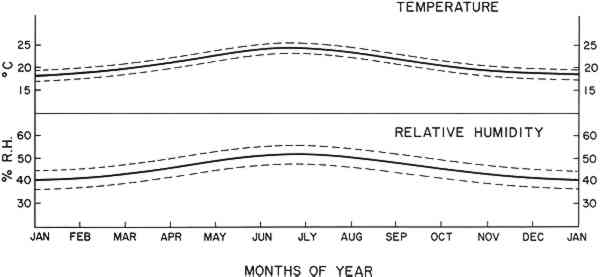CONSERVATION POLICY AND THE EXHIBITION OF MUSEUM COLLECTIONSNATHAN STOLOW
3 ENVIRONMENT PLANNING AND CONSERVATIONEnvironmental factors have been referred to in the previous section, but will be elaborated upon in relationship to museum buildings, and their component parts. It is perhaps redundant to emphasize that the condition of an object is the result of the sum total of all its exposures to deterioration factors: during storage, conservation treatment, exhibition, and movement (travel). The housing of collections has therefore an important bearing on conservation. Museum architecture is a rather specialized field that does not have a long enough history or experience to offer guidelines and specifications for conservation. While progress has been made in developing newer approaches to exhibition halls, lighting and storage; humidity control, air movement, and filtration still pose great difficulties for the architect and the mechanical engineer. The conversion of older structures for museum use is a complex matter; likewise is the upgrading of the physical environment of museums built years ago. The concept of collaboration between architect and conservation specialist is rather recent. This new approach was incorporated in a number of the conclusions reached at the ICOM-UNESCO Symposium on Museum Architecture, Access, and Circulation, Mexico City 1968.19 Relevant conclusions are extracted:
In some institutions surveys are conducted of museum buildings to establish their conservation-worthiness. Such surveys tend to be detailed, including records of humidity and temperature, and light intensity readings. The American Association of Museums embarked on a Museum Certification Program, a number of years ago, in which among a number of factors, environmental stability is assessed. In Canada, the National Gallery, many years ago, categorized art museums A, B, C, or D in descending order of professional and technical excellence. Building and environmental surveys are not only very important to the occupants and the collections housed, but also to other institutions who wish to lend or borrow objects. An inventory of building survey reports, including reliable historical data on relative humidity, temperature, air quality, and light levels would be very valuable to conservators and exhibition organizers. The weak point is the reliability of the instruments used in surveys, and the selection of locations for measurement of the various factors. The matter of level of relative humidity to be maintained for collections is still unsettled. It is generally agreed upon that constancy with narrow variation is essential for maintaining dimensional, or geometric stability for hygroscopic objects. It is also accepted that the temperature factor is less critical in these considerations. In 1960, ICOM carried out an international survey7 on desirable norms for relative humidity and temperatures. The answers were forthcoming from 3 archival institutions in Europe, and 29 major museums and galleries in Europe and America. The desirable levels varied considerably from highs of 60–70% to 45–50% for relative humidity, and from 15–22� C for temperatures. Obviously, there should be another survey, more detailed in nature, covering many more institutions and, this time, segregating the norms for classes of objects; e.g., paintings, works on paper, archival objects, sculptures (hygroscopic or otherwise), textiles, leather, ethnographic objects, ceramics and metals. Permissible variations should also be included, along with external climatic data for each reporting institution. In the author's experience with Canadian museums,20 there has been flexibility in the control levels over a twelve-month period to take into account the preservation of the building in a difficult climate. Thus in the winter time, the relative humidity can be set at 40 � 5%, and permitted to rise to 50 � 5% in the summer. The temperatures can likewise be programmed
As regards lighting not much has been written on the conservation side since 1964.8 Generally, works on paper and textiles are being displayed at recommended low levels of ultraviolet-free light, 150 lux and lower, the fluorescent lamps and daylight sources protected with ultraviolet absorbing filters. There appears to be however a return of natural lighting to museums, partly as a reaction to the “dead” and unchanging aspect of artificial light. A compromise solution to this can be the location of windows or skylights remotely from the works of art, offering a psychological relief to the viewer. Architects find this solution attractive. The remaining factor of dust and dirt control can be resolved with filtration systems designed to eliminate dust and dirt particles down to certain levels (e.g. below 1 micron diameter). Atmospheric pollutants, e.g. sulfur dioxide, can be largely removed in filtration/wash system. However, in an industrial environment such pollutants can gain access through doors, windows, etc., and affect works of art. Thus careful attention must be given to the design of all building openings. |
